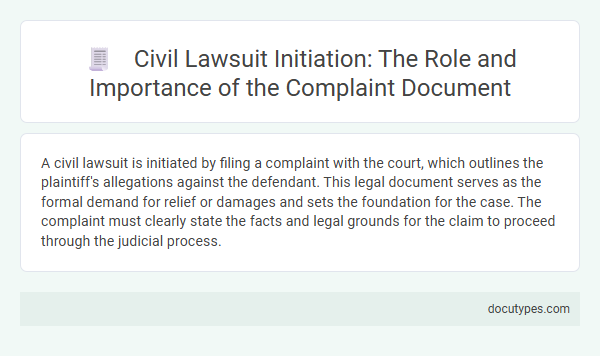A civil lawsuit is initiated by filing a complaint with the court, which outlines the plaintiff's allegations against the defendant. This legal document serves as the formal demand for relief or damages and sets the foundation for the case. The complaint must clearly state the facts and legal grounds for the claim to proceed through the judicial process.
Introduction to Civil Lawsuits
| Introduction to Civil Lawsuits | |
|---|---|
| Legal Document That Initiates a Civil Lawsuit | The primary document that starts a civil lawsuit is called a complaint or petition. This document sets forth the plaintiff's allegations, the basis for the court's jurisdiction, and the relief or damages requested from the defendant. |
| Purpose of the Complaint | The complaint provides the defendant with formal notice of the claims against them. It outlines the facts and legal grounds for the lawsuit, creating the foundation for the dispute resolution process in civil court. |
| Filing Requirement | You must file the complaint with the appropriate court clerk's office and ensure the defendant receives a copy through proper service of process. This step officially launches the civil litigation. |
| Next Steps After Filing | Once the complaint is filed and served, the defendant typically has a limited time to respond with an answer or motion to the court. Failure to respond may result in a default judgment in favor of the plaintiff. |
Definition and Purpose of a Complaint
A complaint is the foundational legal document that initiates a civil lawsuit. It formally outlines the plaintiff's allegations against the defendant.
The purpose of a complaint is to notify the court and the opposing party of the claims being made. It sets the stage for the legal process by defining the issues to be resolved.
Legal Requirements for Filing a Complaint
What legal document initiates a civil lawsuit? The document that starts a civil lawsuit is called a complaint. It must meet specific legal requirements, including clearly stating the plaintiff's claims and the basis for the court's jurisdiction.
Key Elements of a Complaint Document
A civil lawsuit begins with the filing of a complaint, which is the primary legal document initiating the case. The complaint sets forth the plaintiff's allegations against the defendant, outlining the basis for the lawsuit.
Key elements of a complaint include the caption, parties involved, and a clear statement of jurisdiction. It also contains a detailed description of the facts, the legal claims, and the specific relief or damages sought by the plaintiff.
The Role of the Complaint in Civil Procedure
The legal document that initiates a civil lawsuit is called the complaint. The complaint outlines the plaintiff's allegations, the legal basis for the claim, and the requested relief. This document serves as the foundation for the civil procedure, notifying the defendant of the claims and setting the litigation process in motion.
Drafting an Effective Complaint
The legal document that initiates a civil lawsuit is called a complaint. This document outlines the plaintiff's allegations and the legal basis for the claim against the defendant.
Drafting an effective complaint requires clear, concise statements of facts and the specific legal grounds for the lawsuit. Your complaint must include jurisdictional information, a detailed account of the dispute, and the relief or damages sought. Precise language and thorough documentation enhance the chances of a successful case.
Common Mistakes in Complaint Preparation
The legal document that initiates a civil lawsuit is called the complaint. Proper preparation of the complaint is crucial to avoid common mistakes that can delay or jeopardize the case.
- Incomplete Facts - Omitting essential facts or failing to clearly state the claims can lead to dismissal or confusion in the lawsuit.
- Incorrect Parties - Naming the wrong plaintiffs or defendants may result in jurisdictional issues or the need to amend the complaint.
- Poorly Drafted Prayer for Relief - Failing to specify the remedies or damages sought can weaken the plaintiff's position and limit recovery options.
Filing and Serving the Complaint
The legal document that initiates a civil lawsuit is called the complaint. Filing the complaint with the appropriate court officially starts the legal process. Serving the complaint to the defendant ensures they are formally notified of the lawsuit against them, allowing the case to proceed.
Legal Consequences of an Improper Complaint
A civil lawsuit begins with the filing of a complaint, which formally outlines the plaintiff's allegations against the defendant. An improperly drafted complaint can result in significant legal consequences including dismissal or delays in the case.
Legal consequences of an improper complaint impact the plaintiff's ability to proceed and affect the court's management of the case.
- Dismissal of the Case - Courts may dismiss a lawsuit if the complaint fails to state a valid claim or lacks necessary details.
- Extended Litigation Delays - Errors or omissions in the complaint often cause procedural delays as parties may need to amend or clarify pleadings.
- Potential Financial Penalties - Filing a deficient complaint can lead to sanctions or orders to pay the opposing party's legal fees.
What Legal Document Initiates a Civil Lawsuit? Infographic

